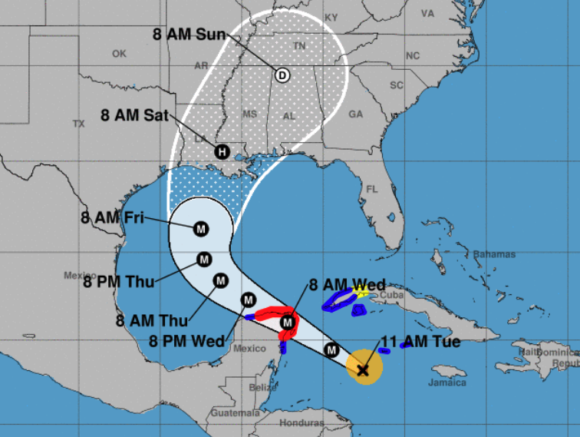Hurricane Delta has strengthened to a building-wrecking Category 4 hurricane as it barrels toward Cancun, where it could cause $10 billion in losses before plowing across the Gulf of Mexico and coming ashore again between Louisiana and Florida.
Delta is rapidly intensifying as it nears the resort city of Cancun at the tip of Mexico’s Yucatan Peninsula, where it could push ocean levels up to 9 feet (2.7 meters) above normal when it makes landfall Wednesday, the U.S. National Hurricane Center said. The hurricane is then forecast to churn through the energy-producing region of the Gulf before likely hitting Louisiana, which has been struck multiple times already this year, on Saturday. Delta had winds of 130 miles per hour as of 11:20 a.m. New York time.
Delta’s winds will intensify to at least 140 mph in 12 hours, the hurricane center said. These winds can snap trees, flatten houses and cause power outages lasting weeks. “Most of the area will be uninhabitable for weeks or months,” the center said.
“Extremely dangerous storm surge and hurricane conditions are expected within portions of the northern Yucatan Peninsula of Mexico beginning tonight,” said Dan Brown, a meteorologist with the center.
Delta threatens to become the latest in a string of deadly natural disasters in 2020, a year that has been marked by a hyperactive hurricane season, devastating wildfires and a derecho that wreaked havoc across the U.S. Midwest. It will be the record 10th tropical storm or hurricane to hit the U.S. in a year. So many have formed that the hurricane center has used up all the names on its official list and has resorted to the Greek alphabet to designate systems.
For Delta, “the strengthening trend that was seen last night is not likely to stop as the storm continues to progress towards the Yucatan Peninsula,” said Elizabeth Palumbi, a meteorologist with commercial forecaster Maxar.
Delta’s winds grew from 70 mph to 110 mph in 24 hours, which is the fastest intensification for an October storm since Hurricane Wilma in 2005, Phil Klotzbach, lead author of the Colorado State University seasonal forecast, said in a Tweet.
Cancun and the nearby island of Cozumel are poised to “get hit hard,” said Chuck Watson, a disaster modeler with Enki Research.
Losses there could reach $10 billion, but a slight wobble in the track could send those amounts as high as $15 billion, he said. Delta could bring another $2 billion in damages and losses to the U.S. coast later this week, depending on its exact path.
Mexico has started to evacuate the hotel zone in Cancun and the island of Holbox as the Yucatan Peninsula readies for the impact of Delta, Quintana Roo Governor Carlos Joaquin said in a tweet. Meanwhile, President Andres Manuel Lopez Obrador said Tuesday he’s sending 5,000 members of Mexico’s armed forces to the Yucatan for prevention efforts.
After Delta loses power over the Yucatan, it’s expected to return briefly to Category 4 strength in the Gulf as it moves toward Louisiana, which was struck by Hurricane Laura in August. Cool water and wind shear in the northern Gulf could weaken Delta, but it will likely make landfall again as a hurricane, said Rob Miller, a meteorologist with AccuWeather Inc.
New Orleans urged residents to “gather food, water & medication for at least three days” in a text via its emergency alert system on Tuesday.
Miller said he expects the storm to strike somewhere west of New Orleans, but storm surge, heavy rains and winds could reach as far east as the Florida Panhandle.
“This region of the county is the magnet for hurricanes this year,” Miller said.
On its current path, the storm will likely cause oil and natural gas production off the Louisiana coast to shut down, and it poses a threat to onshore refineries and shipping, said Jim Rouiller, lead meteorologist with the Energy Weather Group.
“Expect widespread shut-ins of rigs and platforms across the upper Gulf Coast over next two days,” Rouiller said. “Significant impact and disruption to the U.S. energy production area of the upper Gulf is likely as the week wears on.”
The Atlantic has spawned 25 storms this year, the second most on record after 2005, when deadly Hurricane Katrina inundated New Orleans.
–With assistance from Joe Carroll, Lorena Rios and Cyntia Barrera Diaz.
Was this article valuable?
Here are more articles you may enjoy.


 Average U.S. Vehicle Age Approaching 13 Years, New Report Shows
Average U.S. Vehicle Age Approaching 13 Years, New Report Shows  GSK Zantac Appeal Gets Tough Questions From Some US Judges
GSK Zantac Appeal Gets Tough Questions From Some US Judges  Auto Lobbying Groups Unite to Pressure Trump for Tariff Relief
Auto Lobbying Groups Unite to Pressure Trump for Tariff Relief  Forecast Calls for Wildfires to Burn More Land Across U.S. This Year
Forecast Calls for Wildfires to Burn More Land Across U.S. This Year 